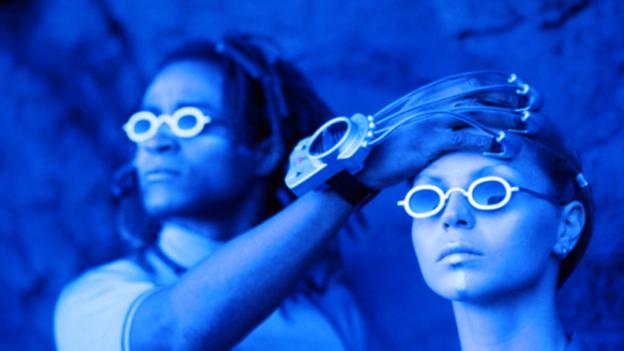It is an amazing story of survival - a parable of how small businesses can use the old ways to make money, but then adapt and prosper down the generations.
Today, the quiet town of Markneukirchen, nestling in the mountains of eastern Germany near the Czech border, would be called an "economic cluster", a place where different companies combine in a close-knit single industry.
But when tradesman started making musical instruments in the town nearly four centuries ago, there was no fancy term for the way they were organised.
It was just the way they did things: violin-makers set up near manufacturers of bows, while the trombone workshop relied on the mouthpiece maker just up the street.
Continue reading the main story
“Start Quote
We only survive because we make special things for special musicians”
Kerstin VoigtVoigt Brass
Today, the town and the valley around it have 113 different enterprises, all involved in making musical instruments. They rely on traditional methods, but utilise all the modern ways of connecting with far-away markets.
Everybody you talk to in the town has a story about how they learnt their particular trade - whether it be making a clarinet or a mandolin or a horn - from their father or uncle, nearly always a male member of the previous generation. They talk of the importance of learning properly by getting their hands dirty.
Behind curtains
This town's remarkable phenomenon started in the 17th Century when a group of Protestants fled across the border from religious persecution in Bohemia.
Among them was a group of instrument makers who settled in Markneukirchen.
By the 1900s, 80% of the world's musical instruments were made in the town.
 Markneukirchen does not just sell its instruments, it can also play them rather well
Markneukirchen does not just sell its instruments, it can also play them rather well
It is a classic German town, with a central plaza, dominated by a church, with cobbled streets running off it. If you go along these streets, you occasionally see a sign or a shop window, indicating the occupant makes zithers or bows, or mouthpieces for trumpets.
But more often than not, you will learn only from an in-the-know local exactly what profitable crafting goes on behind the front curtains.
In Albertstrasse, for example, there is a maker of violin bows and chin rests at number nine and a maker of zithers at number 23. Neither have showy shop fronts - but they do sell to the world. Invariably, manufacturers in the town talk of the importance of high quality.
"We have more than 100 manufacturers of musical instruments," says Frank Bilz, who does much of the marketing for the town's industry.
"Most of them are very small workshops with father, son and mother doing the book-keeping - that's 80% of them. The other 20% are very small to medium-sized companies. And some of them are bigger, with 150 up to 300 employees."
Blood lines
You get a sense from the town that tradition matters - these are not people who swerve to meet the latest fad.
Bjorn Stoll, for example, learnt to make double basses from his father, but in previous generations, the Stolls made strings for basses rather than the complete instruments.
 Markneukirchen has more than 100 makers of musical instruments or parts for them
Markneukirchen has more than 100 makers of musical instruments or parts for them
"My grand-grand-grand-grandfather started in 1835 making strings for instruments," he says. "My grandfather made strings and my father was the first bass maker."
Or take the case of Voigt Brass, set up by Juergen Voigt in 1988. He started learning to play the trombone at the age of 10, and then, at the age of 14, how to make one from his uncle.
He worked for 20 years for a bigger manufacturer, and then, in 1988, he decided to set up on his own at home. Today, he still gets his hands dirty in the workshop but the business is run by his daughter, Kerstin, the ninth generation in the trombone trade.
"It's in my blood," she says.
The business has expanded from the Voigt home to a workshop on the edge of town, but the methodology remains the same: rely on human skill and manual dexterity. There has been investment in machinery and also an embrace of the internet as a sales tool, but it remains a high-skill manual operation.
Chinese competition
 Kerstin Voigt says the business is in her blood
Kerstin Voigt says the business is in her blood
How can such companies and their old-fashioned ways compete with China?
Kerstin Voigt accepts that China can mass produce cheaply, but says her company gets its edge because it tailors instruments to the needs of musicians. If someone wants a particular mouthpiece, that's what they get.
"We only survive because we make special things for special musicians," she says.
The bass maker, Bjorn Stoll, echoes that: "China is no problem for me. China makes low price and low quality. China also makes good quality, but the good quality is expensive. Good musicians in China want European instruments."
That is a recurring theme among the instrument makers of Markneukirchen. Long-lasting profits depend on high quality produced with a keen eye to costs and price. They do not simply go for cheapness.
Communist past
During the days of communism, the former East German regime realised the value of the industry to its foreign-exchange coffers.
The businesses in the town were reorganised collectively. Foreign demand was assessed by the state trading agency, and the makers of instruments were allocated schedules of production in January to fulfil through the year.
The instruments were given to the agency in return for wages and then exported for hard currency. The state, in turn, was very grateful for the foreign exchange, so much so that the musical instrument makers were celebrated on stamps.
 East Germany celebrated Markneukirchen's success in stamps
East Germany celebrated Markneukirchen's success in stamps
Academics from all over the world have come to Germany to try to find out how the highly-successful "mittelstand" of small and medium-sized companies can be replicated.
From Markneukirchen there are suggestions, but no single, clear answer - no obvious mystery ingredient X which might be copied and emulated around the world.
The trombone manufacturer, Kerstin Voigt, says simply: "Tradition."
But companies that stick with tradition too long go out of business. What she does is keep the traditional ways of manufacturing which she learnt from her father, but employ machinery where possible - provided quality is not compromised.
They cannot compete on price with low-wage, ultra mass-producers, but they can compete at the higher end of the market where quality counts.
And they believe strongly in training the next generation. There is a belief in continuity - of learning the basics and adapting to meet new markets.
They are people who find virtue in doing something well.


































